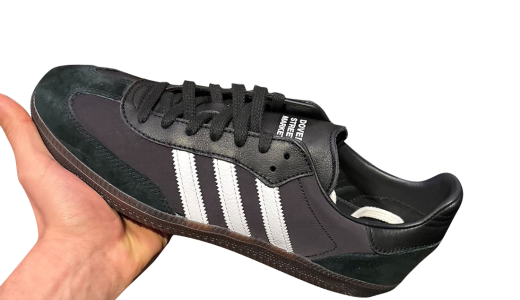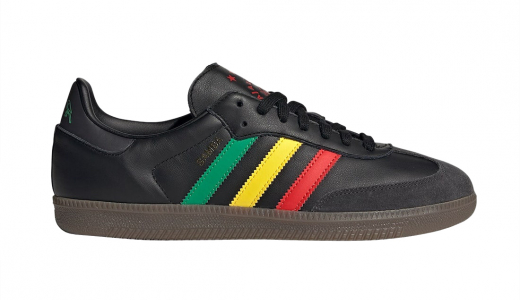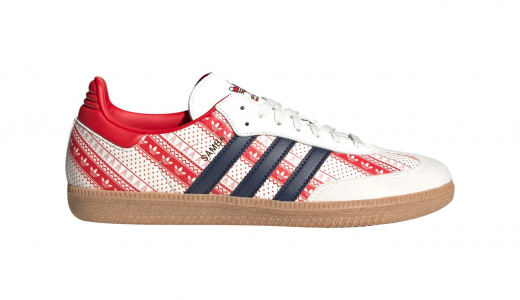Adidas Samba
The adidas Samba is one of the most iconic and enduring athletic shoes ever created. Introduced in the 1950s primarily as an indoor soccer shoe, the Samba has transcended its original purpose to become a staple in both the sporting world and casual streetwear. Its design features a sleek leather upper, a distinctive T-toe overlay for added support, and a durable gum rubber outsole that provides excellent grip on various surfaces. The shoe has been embraced by athletes for its performance and by style enthusiasts for its timeless, versatile look. Over the decades, the Samba's appeal has only grown, making it a significant cultural artifact that bridges the gap between function and fashion.
The enduring popularity of the adidas Samba can be attributed to its ability to adapt to changing trends while maintaining its classic design elements. Various iterations and collaborations have been introduced, keeping the model fresh and relevant in an ever-evolving market. Whether used for athletic purposes or as a fashion statement, the Samba has made a lasting impact, influenced by its rich history and continuous innovation. Celebrities, musicians, and everyday people continue to sport the Samba, further solidifying its place in the pantheon of great athletic shoes. Its legacy is a testament to adidas's commitment to quality, performance, and design excellence, ensuring that the Samba will remain a beloved shoe for generations to come.
History of Adidas Samba
The Adidas Samba: A Historical Odyssey
The Adidas Samba is a legendary figure in the pantheon of athletic footwear, with a tale that stretches over decades and crosses numerous cultural and sporting boundaries. Its iconic status has been cemented by its timeless design and versatility, making it a permanent fixture in sportswear and street fashion alike. This history of the Adidas Samba explores its origins, evolution, and impact from the mid-20th century to the present day.
Origins and Early Development (1949-1950s)
Adidas, the German sportswear giant founded by Adi Dassler in 1949, quickly established itself as a premier manufacturer of athletic footwear. By 1950, the Samba was introduced as a football training shoe specifically designed for icy and hard outdoor surfaces. It was originally intended to enable footballers to train on frozen ground, an innovation that offered significant utility given the harsh winters in Europe.
The early versions of the Samba featured a kangaroo leather upper and the now-famous gum sole, which provided excellent grip. The shoe's name, "Samba," was inspired by the vibrant Brazilian dance, symbolizing agility and quick footwork. It was a subtle nod to the agility required in football, no matter the weather conditions.
The 1960s-1970s: Transition Beyond Football
While initially created as a technical training shoe, the Samba's sleek design and functionality helped it transcend the confines of the football pitch. By the 1960s and 1970s, it began receiving attention beyond football circles. The design evolved moderately, with refinements to the comfort and aesthetic values of the shoe, extending its appeal.
The Samba became popular among indoor football players, or "futsal" athletes, where the durable gum sole ensured superior traction on indoor surfaces. This adaptation to various forms of football helped maintain and even increase the Samba's relevance.
Beyond the sporting realm, cultural shifts during the 1960s and 1970s also contributed to the Samba's growing popularity. The rise of casual fashion influenced by sportswear meant that young people began to incorporate the shoe into their daily wardrobes. The Samba, with its distinctive three stripes and minimalist profile, resonated with the emerging youth cultures across Europe and North America.
The 1980s: Rising Global Popularity
The 1980s marked a period of substantial growth for the Adidas Samba, both in terms of sales and cultural significance. One of the critical drivers of this growth was the burgeoning football culture around the world. The availability of live football broadcasts and international tournaments helped spread the appeal of the game—and its associated gear—to eager young audiences globally.
Additionally, the Samba became a staple within various subcultures. In the UK, it found a place within the “casual” subculture, which revolved around football fans known for their distinct fashion sense. The shoe's practicality and clean aesthetic dovetailed perfectly with the casuals’ preference for sportswear and high-street brands.
Over in the United States, the rise of hip-hop culture in the streets of New York saw the Adidas Samba—and other Adidas footwear like the Superstar—gaining traction among break-dancers, graffiti artists, and DJs. The shoe's durability and comfort made it a favored choice for many who were part of this vibrant, emergent culture.
The 1990s: A Mainstream Icon
By the 1990s, the Samba had firmly entrenched itself as a mainstream icon. Adidas recognized the importance of its classic silhouettes and focused on maintaining the original design ethos of the Samba while also releasing various iterations and updates.
During this decade, the Samba was not just a sports shoe but also a fashion statement. It was worn by celebrities, musicians, and fashion-conscious youth who appreciated its retro vibe and versatile styling. The original black-and-white colorway remained the most popular, but new color combinations were released to suit a diversifying market.
In tandem with the rise of global sneaker culture, the Adidas Samba's identity solidified as a must-have sneaker, balancing athletic functionality with casual streetwear appeal. Its simplicity, comfort, and recognizability made it a go-to for a broad demographic.
The 2000s: Reinvention and Special Editions
Entering the new millennium, Adidas continued to innovate while respecting the heritage of the Samba. The brand released various special editions and collaborations that kept the Samba relevant to new generations. These collaborations often involved artists, designers, and other brands, bringing fresh perspectives to the classic design.
In the 2000s, the rise of digital culture and e-commerce also changed the way people bought and perceived sneakers. Sneaker enthusiasts could now access limited editions and exclusive releases online, fostering a global community of collectors and fans. The Samba, with its rich legacy, remained a coveted item within these circles.
Another significant development during this period was the embrace of retro and vintage styles in mainstream fashion. This trend played directly into the strengths of the Samba, with its timeless design and historical pedigree getting renewed attention. The vintage appeal of the Samba fit perfectly with the nostalgia-driven trends that were prevalent throughout the decade.
The 2010s: Sustainability and Cultural Integration
During the 2010s, broader societal trends started influencing the fashion and sportswear industries more profoundly. Among these was a growing emphasis on sustainability. Adidas, with its global footprint, undertook various initiatives to reduce its environmental impact. While the Samba's design remained relatively consistent, the materials used in production saw innovations aimed at sustainability, such as incorporating recycled materials.
Additionally, the cultural cachet of the Samba was reinforced by its seamless integration into diverse stylistic contexts. No longer confined to sports and streetwear, the Samba found itself in contemporary fashion runways and lifestyle magazines. It became emblematic of a "retro-cool" aesthetic that appealed across age groups and geographies.
The sneaker’s adaptability shone as it became part of various wardrobe styles—from hipster ensembles to minimalist Skandinavian fashion and urban streetwear. The Samba’s design simplicity worked as a blank canvas, allowing individuals to imprint their unique styles onto it.
The 2020s: Contemporary Relevance and Future Prospects
As we enter the 2020s, the Adidas Samba continues to retain its relevance. The sneaker market is more competitive than ever, with numerous brands vying for consumer attention. Nevertheless, the Samba’s enduring charm lies in its history and simplicity.
Adidas has capitalized on this by reissuing classic styles while also pushing the envelope with new collaborations. For instance, collaborations with designers like Yohji Yamamoto and streetwear brands like Palace Skateboards have breathed new life into the Samba. These limited-edition releases often sell out quickly, underscoring the shoe's ongoing desirability.
Moreover, the current fashion climate, with its emphasis on mixing high and low fashion, has seen the Samba being paired with luxury items, high street fashion, and even avant-garde pieces. This versatility has ensured that the Samba remains a relevant choice for a wide range of fashion-conscious individuals.
In addition, Adidas’ commitment to sustainability continues to influence its product lines, including the Samba. Recent iterations have included versions made with sustainable materials, meeting the demands of environmentally-conscious consumers without compromising on the style and durability the Samba is known for.
Conclusion: The Legacy of the Adidas Samba
The Adidas Samba’s journey from a football training shoe to a global fashion icon is a testament to its timeless design and versatility. Over the decades, it has remained relevant by continuously adapting to changes in sport, culture, and fashion, while staying true to its original ethos.
In essence, the Samba manages to be many things to many people—a reliable athletic shoe, a fashion statement, a cultural symbol, and a nostalgic throwback. Its simple yet effective design has enabled it to traverse various cultural landscapes and fashion trends while maintaining a strong identity.
The story of the Adidas Samba is far from over. As the 21st century progresses, it is likely that this storied shoe will continue to evolve, reflecting changes in technology, culture, and consumer values. However, its core—rooted in functionality, style, and heritage—will likely remain untouched, ensuring that the Samba’s legacy endures for generations to come.
In the end, the Samba's journey underscores a central tenet of great design: timelessness. By bridging its rich past with an adaptable present and future, the Adidas Samba exemplifies how a piece of sportswear can transcend its origins to become a lasting symbol of culture, sport, and fashion.























